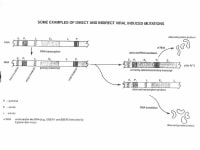Pauling et al. (1949) used electrophoresis to identify structural differences between normal and sickle hemoglobin. Their findings gave rise to molecular genetics and orthomolecular medicine.
The discoveries of HIV, AIDS and their consequences introduced needs for rigorous studies of functional molecular differences. For example, early findings of co-morbidities with Kaposi sarcoma and acid-labile ?-interferon in clinical laboratory reports of persons with HIV/AIDS provided intriguing clues of “autotoxicity,” “autovirulence” and “context-specificity” (Figure 1; Smith, 1984; Smith et al., 1984a; Smith et al., 1984b). Whereas autotoxicity subsumes all prion processes (cf. Prusiner, 2012), autovirulence introduced a need to investigate novel, de novo and aberrant transcription and translation epigenetic byproducts (GERRs).
Many GERRs may be caused by transmissible and infectious small RNAs associated with the Epstein-Barr virus [EBV] and selected adenoviruses (e.g., EBER-1 and EBER-2; and, VA-I and VA-II; Figure 2). Their consequences may include molecular mimicry, autoimmune sequelae, trinucleotide repeat disorders, neuropsychiatric disorders, congenital conditions, hemoglobinopathies, tauopathies, and panoply of other syndromes (Smith, 2009; Fisher, 2009).
The preliophic moleculator (i.e., PRotonic-ELectronic-IOnic-PHotonIC; Smith and Shadel, 2010) and preliophic processes can be used to investigate autotoxins, autovirions, context-specificity, other GERRs and their downstream consequences. These devices and processes now give rise to novel perspectives on etiology, pathology, and, transmissible and infectious processes, along with increased parsimony in molecular biology. The devices and processes ultimately may find application in extraterrestrial research.
References
Fisher, C. (2009). A Novel and Potentially Groundbreaking Viral Theory of Autism and Schizophrenia. Behavioral Medicine Report (Available online at ; Thursday March 19th, 2009).
Pauling, L., Itano, H. A., Singer, S. J., and Wells, I. C. (1949). Sickle Cell Disease, a Molecular Disease. Science 110:543-548.
Prusiner, S. B. (2012). A Unifying Role for Prions in Neurogenerative Diseases. Science 336, 1511-1513.
Smith, R. W. (1984). AIDS and 'Slow Viruses'. Annals of the New York Academy of Sciences 437, 576-607.
Smith, R. Wm. (2009). Inferring an Autovirulent Epigenetic Etiology for the Autism Spectrum and Schizophrenia. Palo Alto, CA: Institute for Postgraduate Interdisciplinary Studies.
Smith, R. W., Rouse, R., Pearson, G. & Hu, C. (1984a). Evidence of Epstein-Barr Virus Antigens in Kaposi's Sarcoma. Clinical Research 32(2):615A (abstract).
Smith, R. W., Rouse, R., Pearson, G. & Hu, C. (1984b). Evidence of Epstein-Barr Virus Antigens in Kaposi's Sarcoma. J. Investigative Dermatology 82(4):423 (abstract).
Smith, R. W. and Shadel, R. R. (2010). Preliophic Moleculator Using Electric Fields and Gradients for Manipulating Molecules. US Patent #7,826,974 B2 (November 2, 2010; also see and ).
Like this entry?
-
About the Entrant
- Name:Roulette Smith
- Type of entry:individual
- Patent status:patented








